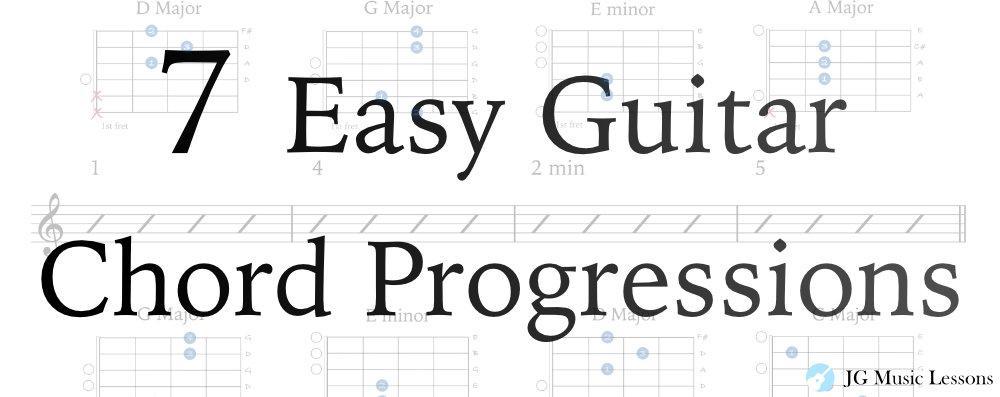A great way to learn the guitar is by mastering the basic chords and putting them together in a chord progression. This simply means a series of chords that are repeated to create the structure of a song.
This lesson covers 7 easy guitar chord progressions to help you understand what chords work together. You can use these chord progressions to help you compose music and also practice switching between chords.
We will use open chords for these examples, meaning that one or more strings are unpressed. This will make it easier to stay in one position of the guitar.
Grab your guitar and let’s get started!
Creating chord progressions
If you need some ideas for creating chord progressions, there are different theory tools you can use such as thinking of related chords (known as diatonic chords). For example, if you’re writing in the key of D Major, you have these related chords which come from the notes of the Major scale:
- 1 Major chord – D Major
- 2 minor chord – E minor
- 3 minor chord – F# minor
- 4 Major chord – G Major
- 5 Major chord – A Major
- 6 minor chord – B minor
- 7 diminished chord – C# diminished chord
Generally, you could put these chords together in different orders and they would work well together because they are directly related from one scale. There are exceptions with the 7 diminished chord which has some specific ways in how its best used within a progression.
You can check out this other post to learn all the related chords in every Major and minor key.
Now that you have a better idea of related chords within a key, let’s begin to apply them on the guitar.
Easy 3 chord progression – 1, 4, 5
For the first progression, we’ll be playing in the key of A Major. The 1, 4, and 5 chord are A Major, D Major, and E Major.

Pop chord progression – 1, 6 min, 4, 5
We’ll play the following simple chord progressions in the key of G Major. The 1, 6, 4, and 5 chord would be G Major, E minor, C Major, and D Major.

Pop progression – 1, 4, 2 min, 5
In the key of D, the 1, 4, 2 min, and 5 chord are D Major, G Major, E minor, and A Major.


Pop rock progression – 1, 5, 6 min, 4
In the key of G Major, the 1, 6 min, 5, and 4 chord are G Major, E minor, D Major, and C Major.

Easy minor chord progression – 1 min, 4 min, 5
Here is an example of an easy minor chord progression. This means that a minor chord is the tonal center. We will play this in the key of A minor. The 1 min, 4 min, and 5 chord are A minor, D minor, and E Major.
Note that we can also change chords within a key to create different musical effects. For example, in a minor chord progression, the 5 minor chord is typically changed to a Major quality to create stronger tension.

Minor chord progression – 1 min, b3, b6, 5
In the key of A minor, the 1, b3, b6, and 5 chord are A minor, C Major, F Major, and E Major.

If the F chord is difficult for you to play, you can simply play strings 4 through 2 or play it as an F Major 7 chord with the open 1st string. For other options, check out 13 ways to play an F Major chord.
Minor chord progression – 1 min, b7, b6, 5
In the key of A minor, the 1, b7, b6, and 5 chord are A minor, G Major, F Major, and E Major. This is sometimes referred to as a Spanish or Flamenco chord progression.

For more examples, see this post on how to play chord progressions in minor keys.
Wrapping up
In this post, we covered 7 easy guitar chord progressions which you can practice once you learn the essential guitar chords. Learning these common 3 and 4 chord progressions are a fun and practical way to help you to kickstart your guitar learning journey.
To get the most out of these chord progressions, try playing them over different time signatures and strumming patterns.
After learning to play these chord progressions using open chords, the next step would be to play them in different keys by using barre chords. You can check out this other post on how to play barre chords on guitar and 5 tips to get better at playing them.
📘 Get the free guitar practice guide here!
Best,
JG
Start Playing Better, Faster
with Pro Membership! ✨
Get the guidance, tools, and support that keep your progress on track:
🏁 Always know what to practice next. Access the full Guitar Learning Roadmap with lessons in sequence.
🎼 Play songs with confidence. Step-by-step lessons of popular, classical pieces and other styles.
📙 Save time and frustration. Clear PDFs and ebooks that save time so you can focus on playing.
🎟️ Get rewarded for consistency. 2 free downloads every month (a $240+ yearly value).
🎁 Keep costs low while you grow. 50% off all charts, tracks, and posters — up to 75% off bundles.
🚫 Stay focused. Ad-free environment keeps you in the zone.
💬 Get help when you need it. Direct member support to keep you on track.

